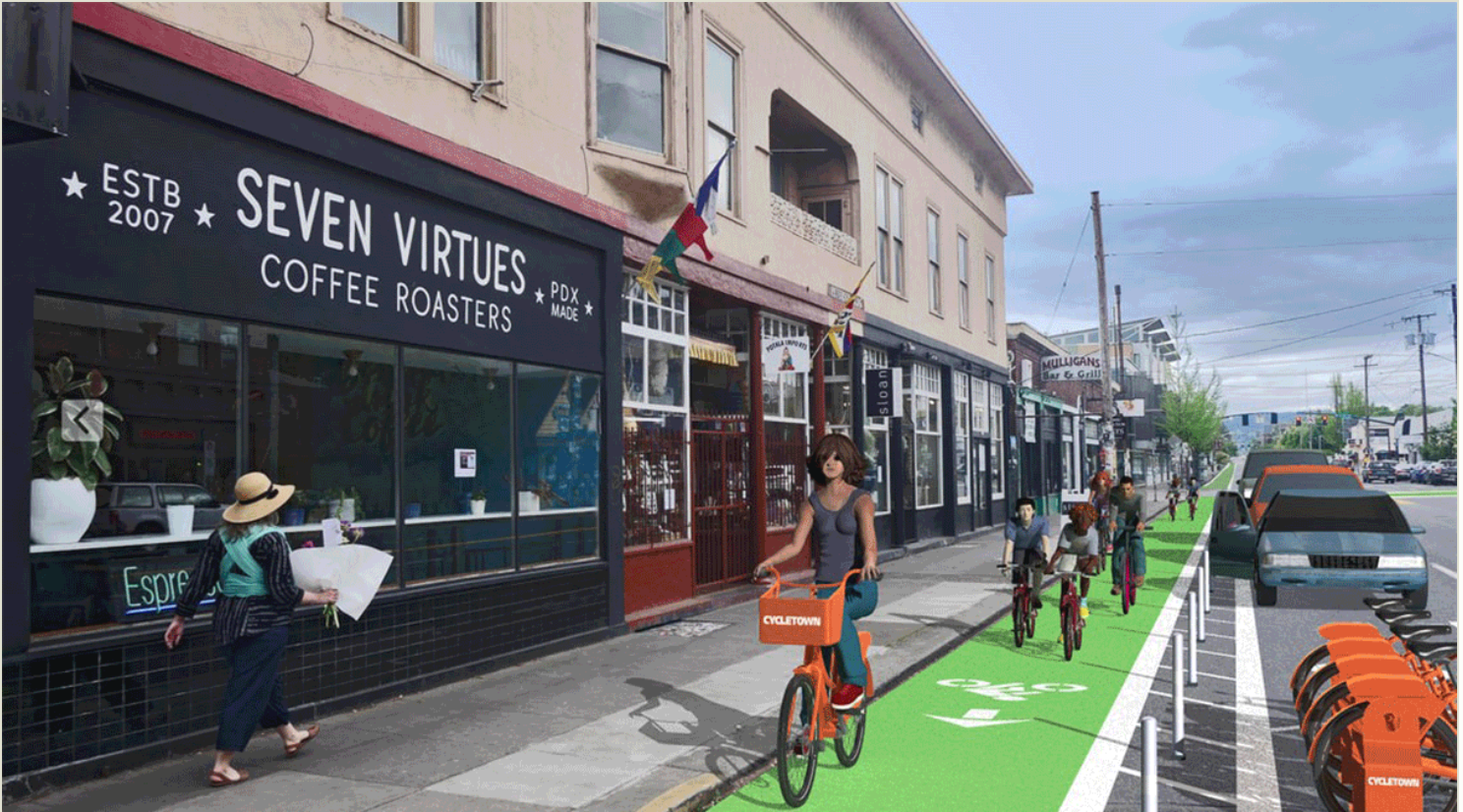Editor's Note: This piece was originally published on Bike Portland is republished here with permission. Though it's a local story, we thought it spoke well to a national audience about both the potential and the pitfalls of citizen-led grass roots efforts to build bike infrastructure, especially in the context of a commercial landscape whose business owners have been resistant to protected bike infrastructure for close to thirty years — until now.
For the past month, Portland resident Zach Katz has been relentlessly promoting the idea of bike lanes on one of Portland’s most high-profile commercial main streets. His Healthier Hawthorne project has taken flight, going from one person’s idea, to a petition (signed by 455 people so far), to a Facebook page (now with 158 members), to a website with slick illustrations (like the one above) — all at breakneck speeds.
We’ve seen many of these lone wolf activism efforts over the years, but few can rival Katz’s energy, execution and focus. His latest move was to waltz into Hawthorne businesses and introduce himself: “Hi, I’m Zach,” the pitch went. “I started a campaign to build protected bike lanes on Hawthorne, is that something you’d be supportive of?”
And despite the popular narrative that business owners abhor the idea of bike lanes “taking away” parking spots, Katz has been overwhelmed with support. Of the 70 business owners and managers he’s heard from so far, 57 have pledged support and only 13 have said no. That’s a big flip-flop from where we were in 2014 when 60 business owners on NE 28th signed a petition in opposition to a “commercial greenway” concept that was proposed as part of the 20s Bikeway project.
Katz thinks it’s a mistake that bicycle users are relegated to backstreets. “Businesses are struggling because there’s no foot traffic, and all the cycling traffic is on neighborhood streets two blocks over,” he shared with us. “Protected bike lanes — especially now, in a world where transit’s future is uncertain — are essential for revitalizing our commercial districts.”
The owner of Backstory Books at 32nd and Hawthorne, Amanda Doimas, said in a press release that, “Once there is a degree of calming on Hawthorne, it will be safe for bikes and safer for pedestrians. Adding bicycles to Hawthorne will add shoppers and neighbors and make it resemble the rest of the city.”
As we reported last month, Katz sees an opportunity to make major changes on Hawthorne as part of the Portland Bureau of Transportation (PBOT) Hawthorne Pave and Paint project that’s gathering steam. PBOT has been careful not to promise too much in the way of bike-specific infrastructure when they re-stripe Hawthorne, but a spokesperson told us back in January that, “This is an opportunity to do something big and bold.”
Even the Hawthorne Boulevard Business Association appears to be open to changes. They haven’t officially supported Healthier Hawthorne yet (we’ve reached out to them for comment but haven’t heard back), but in a recent email to members they said the Pave and Paint project, “Is much more than just resurfacing a road,” and that, “The potential for traffic reconfiguration could have an impact on Hawthorne for decades.”
With a pending PBOT project, decrease in driving volumes due to the pandemic, a boom in bicycle use, brighter bike politics at City Hall of late, and an acute need for small businesses to attract as many customers as possible, we might be headed for a perfect confluence of conditions that could lead to change.

But we’ve seen this movie before. Activism projects led by one person — especially someone like Zach Katz, a young, white man of privilege — can be blind to pitfalls these projects can present. In his short activism stint so far, Katz has already hit a speed bump. Members of his Facebook page vehemently disagreed with him about the design, so he banned them and then deleted the entire comment thread. That set off angry messages and claims he wasn’t open to feedback.
Katz’s idea is also in that honeymoon phase when it’s not yet real enough to attract any serious opposition. Once PBOT says they’re actually considering a bikeway that will reduce access for car drivers, business owners (or the lobby groups that represent them) might change their tune. If/when that happens, given what we’ve seen from Katz so far, I’d say he won’t be deterred easily.
“Now is our chance to transform our neighborhood’s main street into a vibrant place for people — not cars,” Katz said in a statement to BikePortland. “It’s now or never for Hawthorne Boulevard.”
In fact, Katz is so confident and ambitious he’s already added more projects to his portfolio: He’s launched a similar effort to create two “Portland Promenades” on 28th and on Belmont.
Portlanders — If you’d like to learn more about Healthier Hawthorne, join the Bike Loud PDX general meeting tomorrow (5/20) at 6:00 pm. To find out more about PBOT’s Hawthorne Pave and Paint project, the Hawthorne Boulevard Business Association is hosting two public discussions via Zoom: May 20th at 9:00 am and May 27th at 5:30 pm (links to Zoom registration).






